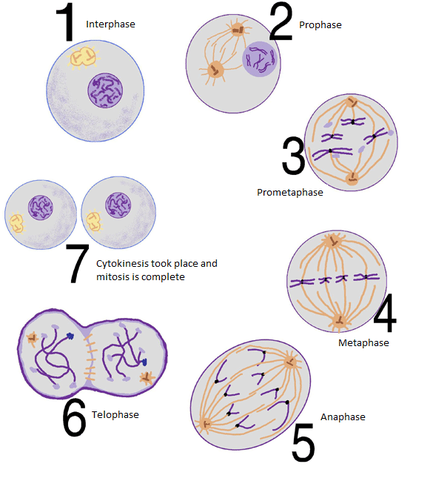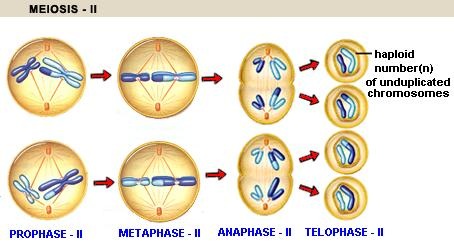- Mitosis is the nuclear division of a cell to produce two identical cells, thus multiplying the population exponentially.
- There are five phases of mitosis, which are preceded by interphase and followed by cytokinesis.
The follow are the combined seven steps of mitosis:
1. Interphase: not usually considered a step in mitosis, the cell spends most of its life in interphase. There are three stages to interphase.
| - G1: The longest stage of interphase, the cell continues on its merry way as a cell, carrying out protein synthesis and other cell jobs. The chromosomes are unable to be discerned, and the nucleus is the only thing visible (with staining).
- S: The cell is preparing for mitosis by replicating the DNA. All chromosomes now have chromatin, or two sets of DNA per chromosome.
- G2: The cell continues to do it's cell duties, but near the end of G2, the cytoplasm organelles will replicate in order to be prepared for cell division during mitosis.
|
2. Mitosis
| - Prophase: Chromatin (what chromosomes are made of) condense. Each chromosome appears as a linked chromatid. Spindles are formed.
- Prometaphase: The nuclear membrane dissolves and the fibers of the spindle connect to the chromatids. The chromatids are linked by kinetochores.
- Metaphase: The chromatids align in the middle of the cell, forming the metaphase plate.
- Anaphase: The chromatids separate and the spindles pull each separate piece to their side of the cell, ensuring that each new cell will have a copy of the chromosome from the parent cell.
- Telophase: The chromosomes are in the opposite sides of the cell, and membranes form around them. Spindle fibers may dissolve.
|
3. Cytokinesis: not usually considered a step in mitosis, animal cells and plant cells undergo different processes during cytokinesis.
| - In animal cells: a fibrous protein ring called actin forms around the center of the cell and contracts, pinching the cell into two.
- In plant cells: a cell plate is synthesized between the two cells, in order to create a cell wall.
|
And thus, mitosis is complete!

Animal cell mitosis
Click image to be taken to the source.

Plant cell mitosis
Click image to be taken to the source.
- Meiosis is a type of cell division that occurs in sexually reproducing organisms. It involves two rounds of division, but only one round of DNA replication.
- Meiosis results in four haploid cells (half the chromosomes of a regular, or diploid cell).
1. Interphase: Chromosomes replicate, the same as mitosis.
2. Meiosis I: Meiosis I is very similar to that of Mitosis. The result of Meiosis I is two daughter diploid cells with chromatids that include region of nonsister DNA, which produces genetic variation.
| - Prophase I: The chromosomes are in synapsis, which means they are held together by proteins, and go through the process of crossing over. Crossing over is the process of exchanging segments of DNA of the nonsister chromatids.
- Metaphase I: The chromosomes align themselves in the center of the cell, still in their homologous pairs.
- Anaphase I: The chromosomes separate and are drawn to the poles, with the sister chromatids still attached to one another.
- Telophase I and Cytokinesis: Two distinct haploid cells are formed. The reason these two stages are grouped together is because they occur at the same time. In animal cells, a cleavage furrow forms, and in plant cells, a cell plate forms.
|

Notice how the chromosomes exchange DNA in crossing over during meiosis I.
Click image to be taken to the source.
3. Meiosis II: The result of Meiosis II is two haploid cells from each diploid cell created in Meiosis I, forming a total of four distinct daughter cells from the original cell. The haploid cells are distinct due to the crossing over in Prophase I, and each cell has only half the cells of the original cell (the definition of haploid).
| - Prophase II: There is not a lot of movement in this stage, as sister chromatids are already paired up from Meiosis I. Notice that there is not another interphase, no DNA replication occurs between Meiosis I and Meiosis II.
- Metaphase II: Chromosomes align themselves at the center of the cell. Sister chromatids are not genetically identical anymore due to the crossing over actions in Prophase I.
- Anaphase II: Chromatids separate and move towards opposite poles.
- Telophase II and Cytokinesis: The nuclear envelope starts to reappear, and cytokinesis occurs as it usually does in Meiosis I and Mitosis.
|

Notice the resulting four daughter cells of meiosis II each have unique DNA segments.
Click image to be taken to the source.
It is important to remember that four daughter cells are produced, versus the two produced in mitosis. The crossing over that occurs during meiosis makes each daughter cell unique. In addition, the same process of cell division occurs in each division, and the division is similar to that of mitosis. Chromosomes are only replicated once, and one diploid cell produces four haploid cells.
To review the cell cycle, mitosis, meiosis, and the distinction between sexual and asexual reproduction, bozemanbiology on YouTube has a great video (
x):




